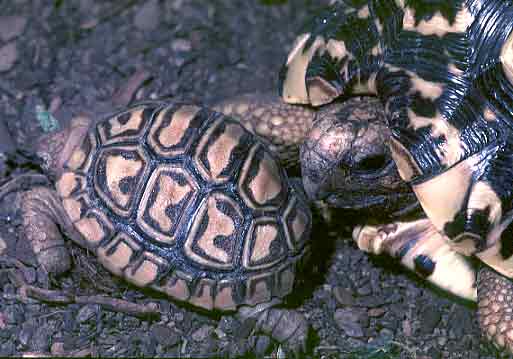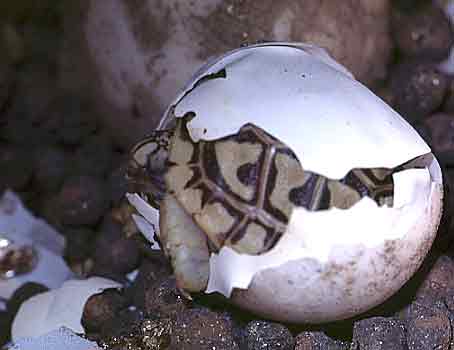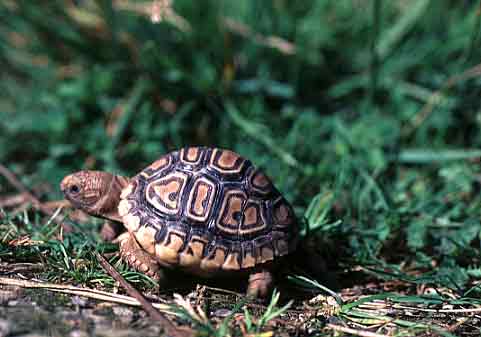
![]() Breeding
the Leopard Tortoise, Geochelone pardalis in
Captivity
Breeding
the Leopard Tortoise, Geochelone pardalis in
Captivity
Andy C. Highfield and Jill Martin

Geochelone pardalis, the leopard tortoise, is the second largest tortoise in Africa, with some populations averaging 500 mm or more carapace length with weights of 15-20 kg although other populations, notably that of the Serengeti, are considerably smaller (the largest tortoise in Africa is Geochelone sulcata, the African Spurred tortoise). Leopard tortoises are probably the most manageable of the medium-large tortoises to maintain in captivity, and in recent years have become very popular indeed with tortoise enthusiasts. Unfortunately, much of this demand has been met by the importation of wild-caught and ‘ranched’ animals, rather than by animals that are genuinely captive-bred. Recent European import restrictions mean, however, that future demand will have to be accommodated by captive bred stock – therefore, it is very important that additional effort is made to refine captive breeding techniques for this species.
Leopard tortoises have a reputation of not being particularly easy to breed in captivity. There are a number of reasons for this. The most common cause of failure, in our experience, is size incompatibility between the male and female. Male leopard tortoises almost invariably select the largest female available to them – unfortunately, while they reason (correctly) that she probably has the best reproductive potential, this is not a lot of help if the size differential means that they cannot even mate successfully with her! Removing the largest animal, and leaving smaller, more appropriately sized, females for the suitor to choose from can make a substantial difference to breeding success.

Leopard tortoises also need a good sized outdoor pen, with plenty of mixed grasses for grazing, and, in cooler climates, heated indoor areas where they can sustain satisfactory body temperatures. Leopard tortoises will not breed if maintained in cramped conditions, or if kept too cold. One of the very best housing methods for these tortoises in summer in moderate climates is a large plastic agricultural ‘poly-tunnel’. Such a building allows good light penetration, provides excellent all-round warmth, and can be landscaped internally to provide cacti, bushes for shade, and an easy-to-drain bathing pond. Access to an uncovered outdoor area for grazing is also essential. The poly-tunnel system allows for relatively easy control of humidity – the tunnel is typically very dry inside (quite suitable for leopard tortoises, which do not tolerate damp at all well), but if you do need to raise the humidity, this is easily accomplished by installing an agricultural mister or sprayer system. As such, the basic poly-tunnel housing system is readily adaptable to a range of environmental requirements, from arid to tropical humid, suitable for Red-foot and Hinge-back species, for example. Although not suitable for over-winter use in northern climates without additional heating, the Poly-tunnel housing system is excellent for extending the space available to many species throughout the spring, summer and fall periods without running up heating costs. To collect heat during the day, and radiate it at night, some metal or plastic 50 gallon barrels, painted matt black and filled with water make excellent ‘storage heaters’. Such a tunnel, planted with palms, yucca trees and cacti, can make quite an impressive display and constitutes a very pleasant environment for the tortoises.
The substrate for leopard tortoises in our own units constitutes a standard sand-soil mixture. To facilitate mating, it is best if this is contoured somewhat, rather than flat. A few ‘hills’ and mounds also assist basking. We have found this substrate to be extremely successful and have had no problems of any kind with it despite using it for several years now. To enhance hygiene, the top layer is scraped off from time to time and replaced with fresh material. An adequate depth of substrate is imperative – especially for females about to nest. These are large tortoises, and nest excavations reflect this. A depth of at least 300 mm (12") is required in nesting areas, even for modestly sized females. Large specimens will require around 450 mm (16"). Some females nest quite late in the day. Indeed, one of our own females habitually nests in the evening. There is always a possibility (in the UK) that she may become too cold as nesting progresses – we have found that positioning a suspended 250 W basking lamp over her until nesting is complete definitely helps in this situation.

Leopard tortoises are prolific animals. Some females produce clutches every 8-10 weeks, and each clutch can contain from 6-20 eggs. These eggs are large and spherical, averaging 40 mm in diameter. Eggs are removed from the nest site after the female has filled the excavation back in with her hind legs, and are taken to our normal tortoise incubators. We place the eggs on a moist vermiculite substrate (the vermiculite is hydrated 1:1 by weight with water), and they are then incubated at 30-31° C. Incubation for leopard tortoise eggs can be a rather extended process – cases have been reported of incubation taking 6 months or more. We generally find that hatching occurs in approximately 5 months, but this is subject to quite a degree of variation, even within individual clutches. As an example, one female laid four eggs on the 31st August 1999, and these all hatched in mid-January 2000. On the 3 November 1999, she laid another clutch of seven eggs. These hatched from the 4th April to 18th May 2000. The resulting hatchlings weighed from 12 to 16 grams.
Leopard tortoises have a reputation as not being especially easy to breed in captivity, but we have found that, even in northern Europe, provided certain conditions are met, and the animals well matched, consistent success can be achieved.
Recommended Reading:
• Practical
Care of Leopard and Sulcata Tortoises
(1999) by A. C. Highfield (video with
book) Carapace Press
• A Beginner’s Guide to Leopard and other South African Tortoises (2000) by Misty Corton (Carapace Press)
• The South African Tortoise Book (1988) by R. C. Boycott and O. Bourquin Southern Book Publishers (out of print)
• The Tortoise and Turtle Feeding Manual (2000) by A. C. Highfield, Carapace Press
• Practical Encyclopedia of Keeping & Breeding Tortoises and Freshwater Turtles (1996) by A. C. Highfield, Carapace Press